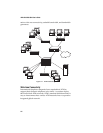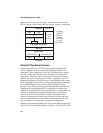
2-1
2
▼▼▼▼
Introducing ATM
Networking
As a technology, ATM represents a sharp departure from LAN
alternatives such as traditional Ethernets that typically rely on
shared transmission media. That is, with Ethernet, several nodes
often contend for the right to transmit over shared cable segments
that support only one transmission at a time. When a node
successfully captures the media, it transmits its message at the
maximum allowed speed, completely consuming the media.
However, even in the best of circumstances, it is not unusual for two
or more nodes to begin transmitting at the same time and interfere
with each others transmission. Ethernet’s design anticipates and
compensates for unpredictable transmission collisions that occur.
How ATM Works
In contrast to other methods, ATM isolates network nodes by forcing
them to attach to ATM switches using dedicated connections. ATM
switches then interconnect and cooperate with each other to form a
network and provide communication connections. While an ATM
node has full use of its switch attachment link, nodes share the
capacity of the links connecting the switches. Unlike Ethernet
networks, this sharing is largely invisible to the nodes. Because of
this and other considerations, ATM provides numerous advantages
and capabilities that are difficult or impossible to obtain with legacy
LAN approaches. Perhaps the most important ATM benefits are its


















